April 16, 2021
The Civic Federation’s recently released Inventory of Local Governments in Illinois report identified a total of 8,923 units of local government in Illinois. This includes 2,826 general purpose governments and 6,097 special purpose governments.
In addition to providing a comprehensive list of local governments in Illinois, the report provides an overview of the different types of local governments in Illinois and their reliance on property taxes and other sources of revenue to fund operations. The report also provides population characteristics of local governments as well as a comparison of the number of local governments in Illinois to other selected states.
The Civic Federation used three primary sources of information to produce the most comprehensive list of local governments in Illinois. These include the Government Master Address File (GMAF) from the U.S. Census Bureau’s 2017 Census of Governments, the Illinois State Comptroller’s registry of local governments, and information provided to the Civic Federation by the Illinois Department of Revenue.
The Civic Federation’s total count of 8,923 local governments in Illinois is greater than the number of local governments reported by the Illinois State Comptroller (8,529), the U.S. Census Bureau (6,918) and the Illinois Department of Revenue (6,042), due to the methodology and the compilation of all three listings to create a composite count. The Federation’s list included in the report is purposefully as inclusive as possible so as to provide a comprehensive view of the totality of local governments in Illinois. The choice to be as inclusive as possible does not mean the other lists are wrong, they simply use different methodologies. You can read more about the differences between the three primary reporting agencies (Illinois Comptroller, U.S. Census Bureau and Illinois Department of Revenue) and the Civic Federation’s list of local governments here.
This blog will examine the township form of government in Illinois.
Of the 2,826 general purpose governments identified by the Civic Federation, which includes counties, townships and municipalities, 1,426, or 50.5%, of those units are townships.[1]
The Illinois Constitution of 1848 granted voters the ability to adopt the township form of government in each county. Townships provide general assistance to the public, provide real estate assessment assistance and maintain township-owned roads and bridges. Townships may also provide a number of youth and senior services and can also provide zoning, police and fire protection, and other services. They are governed by township boards that consist of a supervisor and four other members elected at-large. Townships may also have separately elected highway commissioners, assessors and clerks. Many of the duties of townships overlap with other governments, such as municipalities and counties. Townships are authorized to levy property taxes and issue bonds.
Despite townships being the type of local government with the most units, townships are absent in 17 of the 102 counties in Illinois. [2] The 17 counties without the township form of government operate under the precinct form of government. Precincts (or civil townships) are nonfunctioning, administrative units, with the county performing the administrative functions. The 17 counties in Illinois without the township form of government are:
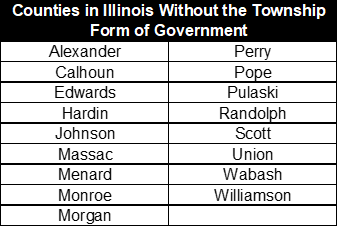
There are a total of 17 coterminous townships and municipalities in Illinois, meaning the township and municipality share the same boundaries. The 17 coterminous townships in Illinois are:
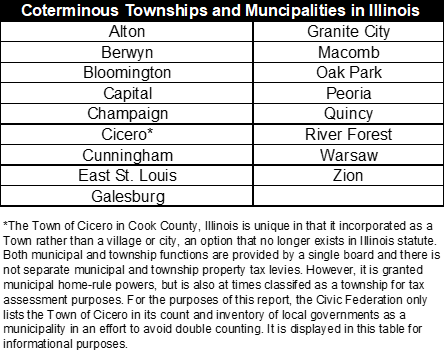
Property Taxes by Type of Local Government in Illinois
The following chart provides an overview of the amount of property taxes levied by type of local government throughout the entire State in 2018. The data in this chart was obtained from the Illinois Department of Revenue. When removing the enterprise zone abatements[3]—$35.4 million statewide—from the total extensions statewide, townships and road districts accounted for 2.4%, or $750.4 million, of the $31.8 billion in taxes levied statewide. School districts’ property tax extensions of $18.5 billion account for 58.3% of the total taxes levied. Municipalities levied $6.0 billion, or 18.9%. Counties levied $2.0 billion, or 6.5%, of the total taxes levied statewide. All other types of governments included in the chart are special purpose governments and account for $4.4 billion, or 14.0% of the total taxes levied statewide. Of these special districts, community colleges levied the greatest amount at $1.2 billion or 3.7% of the $31.8 billion in total property taxes levied statewide.
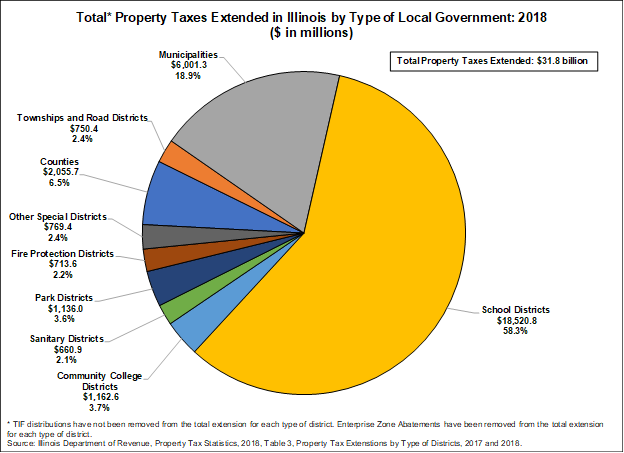
Sources of Revenue for Townships in Illinois
The next chart provides an overview of the various sources of revenue that townships in Illinois rely on to fund operations. The data included in this chart was obtained from the Illinois Comptroller’s FY2018 Fiscal Responsibility Report Card.
Excluding townships that were delinquent in filing their financial reports with the Illinois Comptroller, townships in Illinois collected a total of $747.6 million in revenue. Townships rely heavily on property taxes to fund operations, collectively receiving $606.4 million, or 81.1% of their funding from them. The next largest source of revenue for townships were state sources at $76.5 million or 10.2%. State sources of revenue include shared revenues such as the state income tax and local share of the state sales tax, taxes on gaming, motor fuel and the state replacement tax.[4] Intergovernmental revenues, which are funds received by a local government from another non-federal government, such as a jointly-funded program with another local entity, contributed $4.3 million, or 0.6%. Townships in Illinois received $5.0 million from the federal government, a fraction of the amounts distributed to counties ($251.8 million) and municipalities ($143.9 million). Other revenues totaled $54.8 million, or 7.3%, of spending in FY2018.[5]
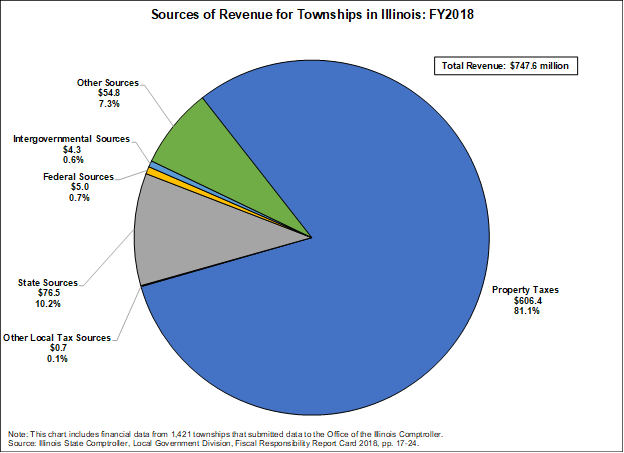
Population Characteristics of Townships in Illinois
According to the U.S. Census Bureau, there are 1,429 townships in Illinois. Nearly 50%, or 709 townships, have fewer than 1,000 residents. Nearly 25%, or 328 townships, have between 1,000 and 2,499 residents. There are 32 townships with a population between 50,000 and 99,999, and 22 townships with a population greater than 100,000 residents. The remaining 338 townships have a population between 2,500 and 49,999 residents. It is important to note that residents of the City of Chicago and 17 other counties do not operate under the township form of government and are therefore not present in the data.
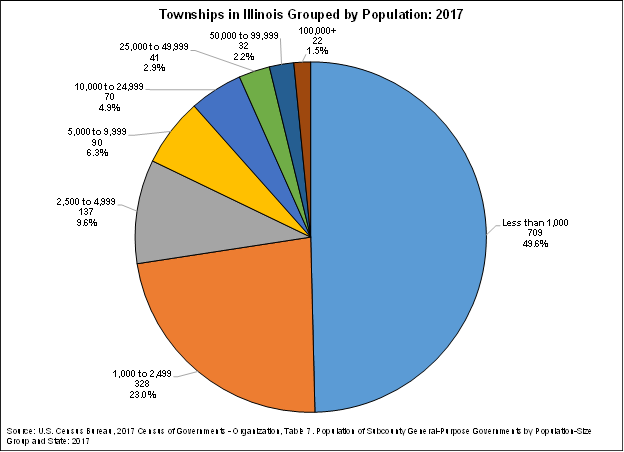
Comparison of Townships in Illinois and Selected States
This chart compares the number of townships in Illinois and selected states. The data in this chart were obtained from U.S. Census Bureau’s 2017 Census of Local Governments. Of the selected states, Minnesota has the greatest number of townships at 1,780, followed by Pennsylvania with 1,546 and then Illinois, with 1,429 townships. Ohio has the most townships after Illinois with 1,308 townships. California, Florida, Iowa and Texas do not have the township form of government. Of the selected states that do have townships, Missouri has the fewest number of townships with 283. According to the U.S. Census Bureau, a total of 20 states have the town or township form of government.
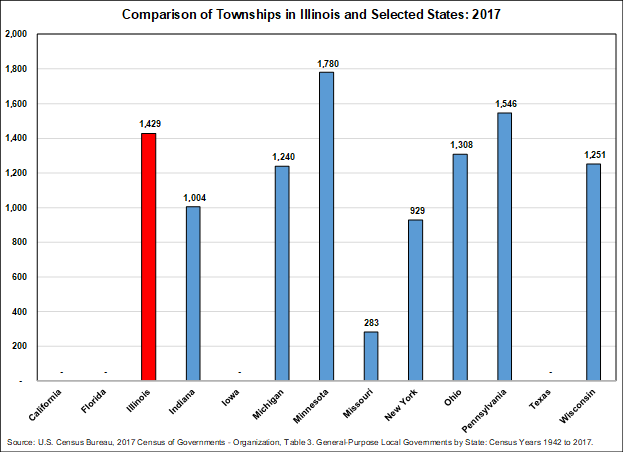
Related Links:
An Inventory of Local Governments in Illinois
An Inventory of Local Governments in Illinois: Differences Among Reporting Agencies
An Inventory of Local Governments in Illinois: Counties
The Multiplicity of Local Governments in Northeastern Illinois
School Districts and Property Taxes in Illinois
[1] West Peoria Township is included in the Civic Federation’s count of 1,426 townships due to the timing and release of the Federation’s report An Inventory of Local of Governments in Illinois. Voters approved the referendum to dissolve West Peoria Township in November 2020.
[2] In Cook County, the City of Chicago does not have the township form of government, but suburban Cook County does have townships.
[3]An enterprise zone is an economic development tool used by local governments to spur development and economic growth. One component of the enterprise zone program is the ability for the increase in assessed value related to improvements made to properties within the enterprise zone to be abated (reduced) by a certain amount. Therefore, the Civic Federation does not include the abated taxes in the data presented.
[4] Illinois State Comptroller, Local Government Division, Fiscal Responsibility Report Card 2018, pp. 20-23.
[5] Illinois State Comptroller, Local Government Division, Fiscal Responsibility Report Card 2018, pp. 17, 24.
